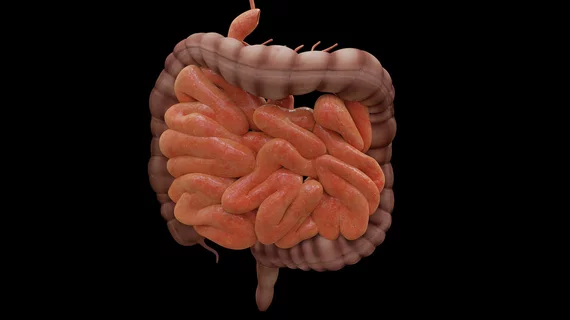Focused abdominal ultrasound is faster and less costly than using the typical fluoroscopic upper gastrointestinal exam to assess pediatric patients with twisted intestines, according to a new analysis published Sunday.
UGI is the standard go-to diagnostic tool for such malrotation of the insides during fetal development. However, it has certain limitations that include exposing children to ionizing radiation and sensitivity that can clock as low as 54%, imaging researchers wrote July 19 in JACR.
Experts with Texas and Cincinnati children’s hospitals recently tested out a new imaging algorithm among more than 100 pediatric patients suspected of having the condition. Ultrasound is emerging as a sound alternative to UGI, the authors noted, with no oral contrast requirements, among other benefits. It’s cheaper, too, costing an average of $127 less per patient compared to UGI, while logging a 35-minute shorter process duration in children with suspected midgut volvulus.
Labor had a substantial influence on costs, the authors noted. For instance, a UGI ranged from as low as $170 when performed by a technologist or radiology practitioner assistant, up to as high as $1,974 when delivered by a radiologist. Ultrasound, meanwhile, started at about $123 when performed by a sonographer, and climbed as high as $1,330 when performed by a rad.
“In many clinical practices, fluoroscopy (including UGI) is almost exclusively performed by a radiologist and a technologist and US examinations are nearly exclusively performed by a sonographer. In these scenarios, the cost differential is greatest,” noted lead author HaiThuy Nguyen, MD, with the Department of Radiology at Texas Children’s Hospital, in Houston, and colleagues. “These findings combined with other advantages of US over UGI, including the lack of ionizing radiation and portability, suggest that US could be a preferred efficient approach, assuming diagnostic performance is adequate.”
To reach their conclusions, Nguyen et al. performed a time-driven, activity-based cost analysis to compare the two modalities. A few years ago, their team of radiologists, surgeons, emergency providers and neonatologists first created a midgut volvulus treatment algorithm that utilizes abdominal US as the first-line imaging response to the condition, while also allowing for UGI as a possible follow-up in certain cases.
Analyzing all UGI and ultrasound exams for suspected midgut volvulus performed at one large, academic pediatric hospital from January 2016 and December 2019, the team found clear benefits for the latter strategy. All told, base pathway times for fluoroscopic GI exams landed at about 90 minutes compared to just 55 for focused ultrasound. Base costs for UGI ranged from about $283 when performed by an assistant up to almost $546 for a radiologist. On the flipside, ultrasound base costs ranged from $156 via sonographer up to $243 from a rad.
The team determined that the institution would break even if about 43% of midgut volvulus cases included ultrasound only, with the other 57% using both US and UGI, versus strictly using the UGI for all patients.
Future studies could potentially explore the diagnostic performance differences between the two. One past analysis, Nguyen noted, estimated that US can tally a sensitivity rate between 86% and 95% for midgut volvulus compared to 54%-79% for UGI.
“Other important variables also should be incorporated into future studies comparing diagnostic strategies,” the team concluded. “Incorporating patient preferences into competing diagnostic strategies for volvulus would also be an avenue for future research,” they added later.
You can read more of the analysis in the Journal of the American College of Radiology here.

